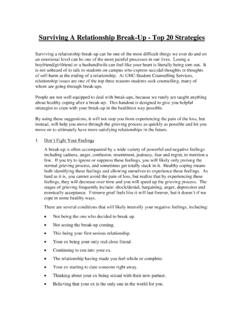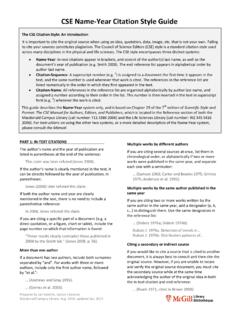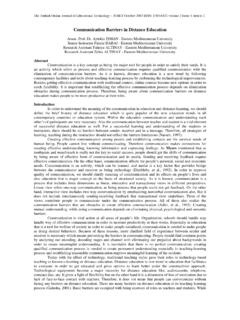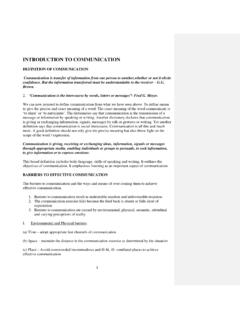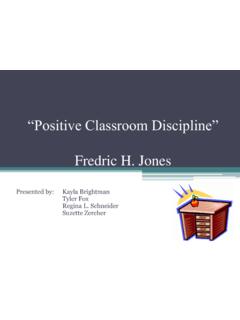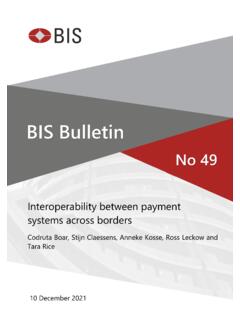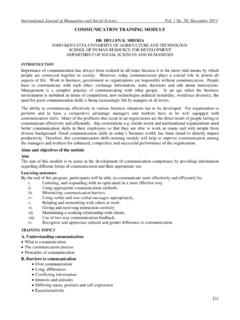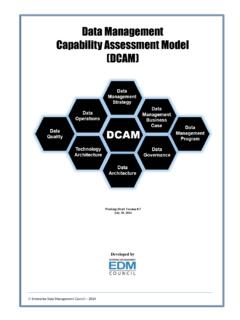Transcription of Communication: The Process, Barriers, And Improving ...
1 SCHOOLING VOLUME 1, NUMBER1, 2010 1 Communication: The Process, barriers , And Improving Effectiveness Fred C. Lunenburg Sam Houston State University _____ ABSTRACT Communication is the process of transmitting information and common understanding from one person to another. In this article, I discuss the communication process, barriers to communication, and Improving communication effectiveness. _____ The study of communication is important, because every administrative function and activity involves some form of direct or indirect communication. Whether planning and organizing or leading and monitoring, school administrators communicate with and through other people. This implies that every person s communication skills affect both personal and organizational effectiveness (Brun, 2010; Summers, 2010).
2 It seems reasonable to conclude that one of the most inhibiting forces to organizational effectiveness is a lack of effective communication (Lutgen-Sandvik, 2010). Moreover, good communication skills are very important to ones success as a school administrator. A recent study indicated that recruiters rated communication skills as the most important characteristic of an ideal job candidate (Yate, 2009). In this article, I will help you to better understand how school administrators can improve their communication skills. To begin, I define what is meant by communication and then discuss the process by which it occurs. Following this, I examine barriers to communication and ways to improve communication effectiveness. Defining Communication and Describing the Process Communication can be defined as the process of transmitting information and common understanding from one person to another (Keyton, 2011).
3 The word communication is derived from the Latin word, communis, which means common. The definition underscores the fact that unless a common understanding results from the SCHOOLING 2_____ exchange of information, there is no communication. Figure 1 reflects the definition and identifies the important elements of the communication process (Cheney, 2011) Figure 1. The communication process. Two common elements in every communication exchange are the sender and the receiver. The sender initiates the communication. In a school, the sender is a person who has a need or desire to convey an idea or concept to others. The receiver is the individual to whom the message is sent. The sender encodes the idea by selecting words, symbols, or gestures with which to compose a message.
4 The message is the outcome of the encoding, which takes the form of verbal, nonverbal, or written language. The message is sent through a medium or channel, which is the carrier of the communication. The medium can be a face-to-face conversation, telephone call, e-mail, or written report. The receiver decodes the received message into meaningful information. Noise is anything that distorts the message. Different perceptions of the message, language barriers , interruptions, emotions, and attitudes are examples of noise. Finally, feedback occurs when the receiver responds to the sender's message and returns the message to the sender. Feedback allows the sender to determine whether the message has been received and understood. The elements in the communication process determine the quality of communication.
5 A problem in any one of these elements can reduce communication effectiveness (Keyton, 2011). For example, information must be encoded into a message that can be understood as the sender intended. Selection of the particular medium for transmitting the message can be critical, because there are many choices. For written media, a school administrator or other organization member may choose from memos, letters, reports, bulletin boards, handbooks, newsletters, and the like. For verbal media, choices include face-to-face conversations, telephone, computer, public address systems, closed-circuit television, tape-recorded messages, sound/slide shows, e-mail, and so on. Nonverbal gestures, facial expressions, body position, and even clothing can transmit messages.
6 People decode information selectively. Individuals are more likely to perceive information favorably when it conforms to their own beliefs, Feedback Medium Noise Message Decode Receiver Encode Encode Sender Decode FRED C. LUNENBURG _____3 values, and needs (Keyton, 2010). When feedback does not occur, the communication process is referred to as one-way communication. Two-way communication occurs with feedback and is more desirable. The key for being successful in the contemporary school is the ability of the school administrator to work with other school stakeholders (faculty, support staff, community members, parents, central office); and develop a shared sense of what the school/school district is attempting to accomplish where it wants to go, a shared sense of commitments that people have to make in order to advance the school/school district toward a shared vision and clarity of goals.
7 As school administrators are able to build a shared mission, vision, values, and goals, the school/school district will become more effective. Building a relationship between school administrators and other school stakeholders requires effective communication. For example, research indicates that principals spend 70 to 80% of their time in interpersonal communication with various stakeholders (Green, 2010; Lunenburg & Irby, 2006; Matthews & Crow, 2010; Sergiovanni, 2009; Tareilo, 2011; Ubben, Hughes, & Norris, 2011). Effective principals know how to communicate, and they understand the importance of ongoing communication, both formal and informal: faculty and department meetings; individual conversations with parents, teachers, and students; and telephone calls and e-mail messages with various stakeholder groups.
8 The one constant in the life of a principal is a lot of interruptions they happen daily, with a number of one- and three-minute conversations in the course of the day. This type of communication in the work of the principal has to be done one on one - one phone call to one person at a time, one parent at a time, one teacher at a time, one student at a time; and a principal needs to make time for these conversations. For example, a principal may be talking with a parent with a very serious problem. She may be talking with a community member. She may be talking with the police about something that went on during the school day. The principal must be able to turn herself on and off in many different roles in any given day.
9 barriers to Effective Communication A school administrator has no greater responsibility than to develop effective communication (Pauley, 2010). Why then does communication break down? On the surface, the answer is relatively simple. I have identified the elements of communication as the sender, the encoding, the message, the medium, the decoding, the receiver, and the feedback. If noise exists in these elements in any way, complete clarity of meaning and understanding does not occur. The author, George Bernard Shaw wrote, The greatest problem with communication is the illusion that it has been accomplished (Shaw, 2011). Four types of barriers (called noise, see Figure 1) are process barriers , physical barriers , semantic barriers , and psychosocial barriers (Eisenberg, 2010).
10 SCHOOLING 4_____ Process barriers Every step in the communication process is necessary for effective and good Blocked steps become barriers . Consider the following situations: Sender barrier. A new administrator with an innovative idea fails to speak up at a meeting, chaired by the superintendent, for fear of criticism. Encoding barrier. A Spanish-speaking staff member cannot get an English-speaking administrator to understand a grievance about working conditions. Medium barrier. A very upset staff member sends an emotionally charged letter to the leader instead of transmitting her feelings face-to-face. Decoding barrier. An older principal is not sure what a young department head means when he refers to a teacher as "spaced out.
